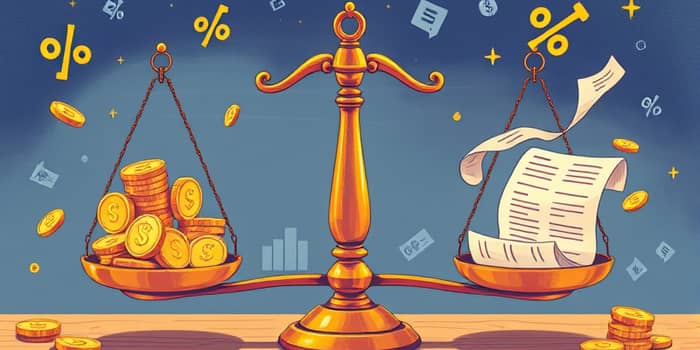Borrowing money can feel complex, but understanding key terms can empower you to make better choices. The difference between an interest rate and APR may determine whether you save thousands or face unexpected costs.
Understanding the Interest Rate
The interest rate represents the basic borrowing cost you pay each year based solely on the principal—the amount you initially borrow. It does not account for additional fees or charges that lenders may impose. When you sign a loan agreement, the interest rate defines your periodic payment schedule and total financing cost.
Interest rates can be offered as fixed or variable. A fixed interest rate stays the same throughout the loan’s term, providing predictable monthly payments. By contrast, a variable rate can rise or fall in response to market conditions, potentially altering your payment structure over time.
Defining Annual Percentage Rate (APR)
The Annual Percentage Rate (APR) goes beyond the simple interest rate by factoring in most fees and charges associated with the loan. This includes origination fees, closing costs, discount points, and other lender-imposed expenses. The APR expresses the total annual cost of borrowing money as a percentage of the principal.
Because APR includes fees, it is almost always higher than the nominal interest rate. Comparing APRs gives you a clearer picture of what you will pay annually, allowing for an accurate comparison of loan offers across different lenders, even when fee structures vary.
Legal Disclosures Under TILA
Under the federal Truth in Lending Act (TILA), lenders must disclose both the interest rate and the APR before you finalize the loan. This ensures transparency and protects consumers from hidden fees. Advertisements for loans must include APR information, allowing you to make side-by-side comparisons.
Compliance with TILA standardizes how lenders present costs, giving borrowers the tools to avoid misleading offers. If the disclosed APR differs significantly from what you later pay, you may have grounds to challenge the lender’s practices.
How APR is Calculated
To compute APR, lenders add the total interest you will pay over the life of the loan to any upfront fees, then divide that sum by the principal amount. They annualize this figure based on the loan term, yielding a single percentage that captures both interest and fees.
An example formula reads:
APR = ((Interest + Fees) / Principal) × (365 / Loan days) × 100
This formula does not account for intra-year compounding; that is measured by APY (Annual Percentage Yield) instead. APR provides a straightforward, legal standard for comparing costs.
APR vs. Interest Rate: Why It Matters
This table highlights why APR is often the better metric for comparing loans. Even if two loans share the same interest rate, differing fees can produce a higher APR for one lender, making it more expensive overall.
Practical Examples
Suppose you take out a $200,000 mortgage at a 6% interest rate. Your annual interest would be $12,000. If the lender adds $4,000 in fees, the APR might rise to 6.5% or more. By focusing solely on the interest rate, you would miss the impact of those fees.
In another scenario, a credit card may advertise an 18% APR with no annual fee, while another card offers 17.5% but charges a $100 yearly fee. The second card’s true cost could exceed the first, despite its lower headline rate.
- Loan without fees: interest rate = APR
- Loan with upfront fees: APR > interest rate
- Credit card balance transfers: promotional APR may be 0%
Fixed vs. Variable APR
A fixed APR remains constant, shielding you from rising rates and making budgeting simpler. This stability can be critical for long-term financial planning, especially with large loans like mortgages.
Variable APRs are tied to benchmark rates such as the prime rate. If market rates climb, your APR can increase, leading to higher payments. While a variable APR can start lower than a fixed rate, it introduces more uncertainty and potential risk.
APR in Credit Cards vs. Loans
Credit cards typically disclose APRs for purchases, balance transfers, cash advances, and penalties separately. Most cards exclude annual fees from the purchase APR calculation. However, any fee directly related to a transaction type will usually be included in that APR.
In contrast, mortgages and auto loans tend to bundle origination and closing costs into their APR calculations. Always check the fine print to see which fees a lender has included, so you can identify hidden costs before committing to a loan.
Using APR to Compare Loans
When shopping for credit, use APR as your primary comparison tool. Look beyond the advertised interest rate to understand what you will pay in total over time. Be wary of lenders highlighting low rates but burying substantial fees in the contract.
- Request loan estimates including APR and itemized fees.
- Compare similar loan terms (term length, fixed vs. variable).
- Check for prepayment penalties impacting total cost.
- Use online calculators to model different APR scenarios.
APR vs. APY: The Role of Compounding
APR does not account for how often interest compounds within a year. That is the realm of APY, which shows the effective annual yield or cost when compounding occurs. Savings accounts and certificates of deposit emphasize APY because it reflects the true growth of your deposit.
For borrowers, APY is less relevant since most loans compound monthly or daily under the terms of the mortgage or note. However, understanding both metrics can help you compare investments and loans on equal footing.
Conclusion: Making Informed Decisions
Mastering the difference between interest rate and APR equips you to navigate the world of lending with confidence. By focusing on the total annual cost of financing, you can avoid surprises and secure the most advantageous deal for your needs.
Next time you evaluate a loan or credit card, insist on APR disclosures, ask questions about included fees, and use side-by-side comparisons. Your wallet—and your peace of mind—will thank you.
References
- https://www.consumerfinance.gov/ask-cfpb/what-is-the-difference-between-a-loan-interest-rate-and-the-apr-en-733/
- https://www.investopedia.com/terms/a/apr.asp
- https://www.equifax.com/personal/education/credit-cards/articles/-/learn/what-is-apr/
- https://www.law.cornell.edu/wex/annual_percentage_rate_(apr)
- https://www.experian.com/blogs/ask-experian/what-is-apr/
- https://www.investopedia.com/ask/answers/100314/what-difference-between-interest-rate-and-annual-percentage-rate-apr.asp
- https://www.debt.com/what-is-apr/
- https://en.wikipedia.org/wiki/Annual_percentage_rate










